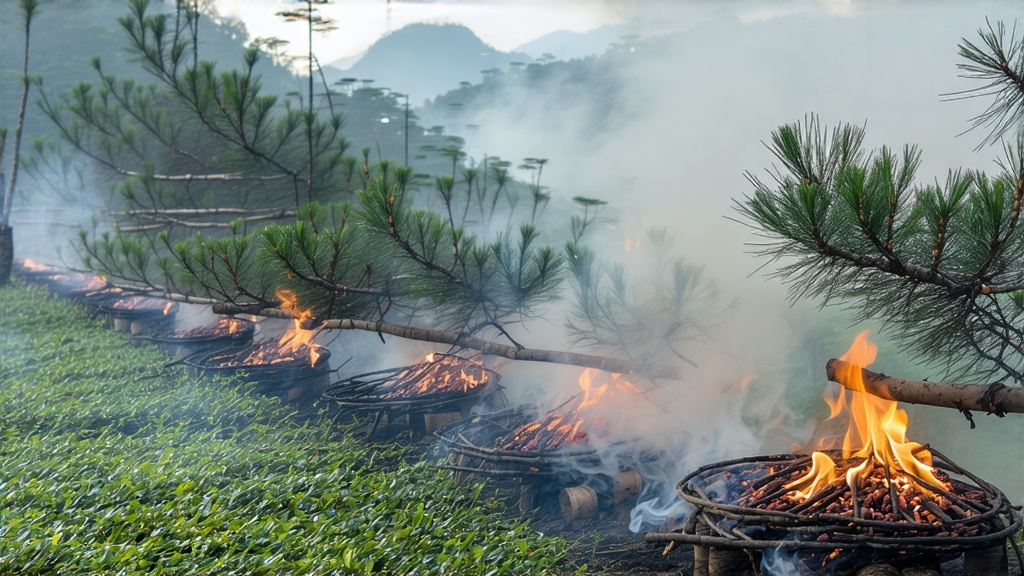
Lapsang Souchong—pronounced “lahp-sang soo-chong”—is the tea that started the global black-tea story. Before Assam, Ceylon or Keemun, there was this small, twisted leaf from the rocky Wuyi Shan of northern Fujian, fired over fresh pine embers in the mid-seventeenth century and shipped down the Min River to waiting Dutch traders. In European account books it first appears in 1640 as “bohea,” a corruption of the local Wu-i hills, and within fifty years it had eclipsed green tea in London auctions, giving birth to the English habit of tea with milk and sugar. Today, despite a thousand black teas on the market, connoisseurs still return to Lapsang Souchong for its primal campfire aroma and the sweet, longan-fruit finish that no other leaf can imitate.
Geography and terroir
The authentic leaf comes only from the high-altitude, mineral-rich core of the Wuyi Mountains known as Tongmu Guan, a protected national park where the river zig-zags through granite cliffs and morning mist lingers until noon. The average elevation is 1,200 m; the average annual temperature is 18 °C. Humidity hovers at 80 %, nurturing wild tea bushes that grow slowly among ferns, orchids and towering Masson pines. These pines are not scenery—they are the fuel that will later perfume the leaf. Because pesticides are forbidden inside the reserve, the bushes must fight their own ecological battles, concentrating aromatic compounds that translate into cup complexity.
Two families, not one
Western shops often sell only the heavily smoked version, but insiders recognise two distinct styles. “Zhengshan xiaozhong” (original mountain small-variety) is the traditional pine-smoked leaf; “wuyi xiaozhong” is the same cultivar processed without smoke, a style created in 2005 for the domestic market that now commands higher prices than its fragrant sibling. Both share the same genetic material—Camellia sinensis var. sinensis, the small-leaf China type—but diverge at the firing stage, giving drinkers a choice between primal smoke or pristine honeyed malt.
Craft: from leaf to legend
Plucking begins in late April, when two leaves and a bud reach the standard called “xiao kai mian” (small open face). The pickers work 4 a.m. to 9 a.m. to keep the dew cool; any later and the sun will volatilise the delicate aromatics. After a brief withering on bamboo trays in the shade, the leaves are rolled by hand for 45 minutes to rupture cells and invite oxidation. The critical step is “song xun”—smoking over fresh pinewood—performed in a three-storey Qing-dynasty building whose upper rafters are lined with woven rattan mats. A pinewood fire is lit on the ground floor; the rising heat and resinous smoke pass through wet tea leaves spread on the middle floor, then escape through roof tiles. Craftsmen control temperature by sprinkling water on the embers and by shifting the depth of leaf, aiming for 28–32 °C for six to eight hours. Finally the leaf is given a high-temperature bake at 80 °C to fix the flavour and reduce moisture to 3 %. The entire process spans 24 hours, supervised without thermometers—only the master’s nose decides when the balance between pine, fruit and malt is perfect.
Modern variations
Inside Tongmu Guan only 2,500 kg of authentic pine-smoked Lapsang are made each spring. Outside the reserve, larger factories use gas ovens and liquid smoke flavouring, producing the acrid, tarry cups that many newcomers mistake for the real thing. A reliable sign of authenticity is the price: below USD 1 per gram it is almost certainly faux-smoke. Another clue is leaf colour—genuine smoked Souchong is charcoal-black with an oily sheen, not dull brown, and carries a faint amber gum line on the stem where pine resin has crystallised.
How to brew: gongfu style
Use 5 g of leaf in a 120 ml gaiwan or Yixing teapot. Rinse once with 95 °C water for three seconds to wake the leaf and wash away surface smoke. First infusion: 10 s, second: 8 s, third: 12 s, adding two seconds each subsequent steep. The liquor runs from deep copper to rose-gold, releasing layers of pine sap